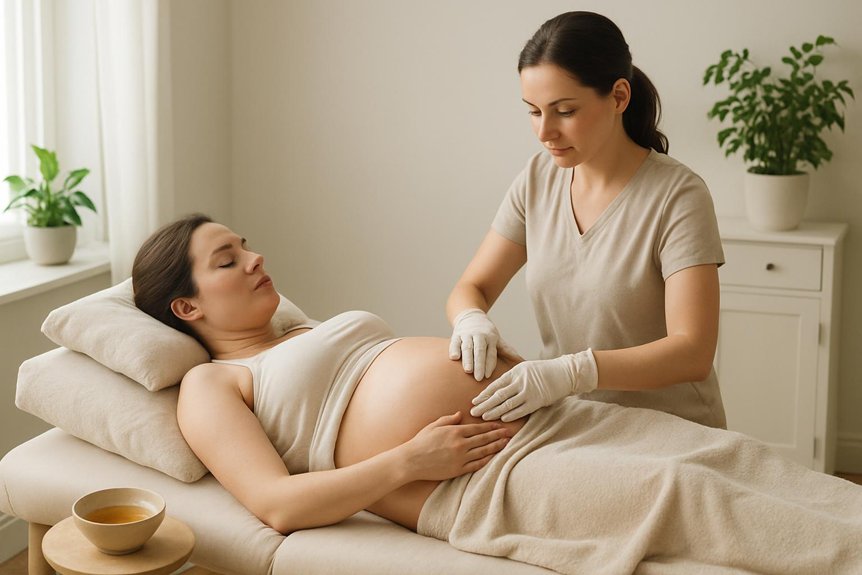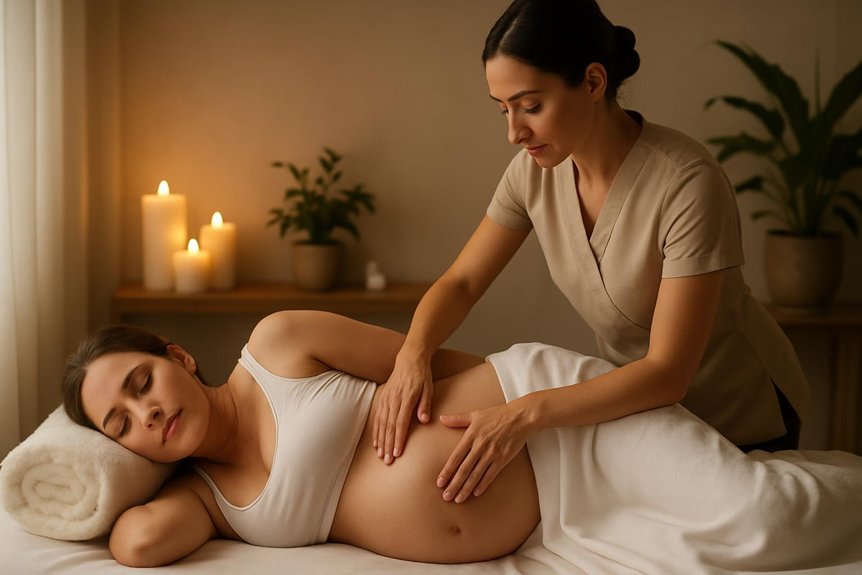Gentle belly massage can be safe in pregnancy with timing, technique, and medical clearance. In the first trimester, avoid direct abdominal work. From the second trimester, light, slow strokes are acceptable if pregnancy is uncomplicated. Use side-lying or semi-reclined positions, minimal pressure, and hypoallergenic oils. Stop if pain, bleeding, dizziness, contractions, or reduced fetal movement occur, and seek advice for high-risk pregnancies. Benefits include relaxation, circulation support, and digestive ease. The guidance below explains when, how, and what to use.
Is Belly Massage Safe During Each Trimester?

Pregnancy’s changing physiology means belly massage safety varies by trimester and technique. In the first trimester, direct abdominal work is approached with caution; gentle, superficial strokes around, not on, the uterus are preferred, with focus redirected to the back, hips, and diaphragm for comfort.
In our London clinics, therapists use side‑lying positioning and avoid deep pressure.
In the second trimester, light, slow effleurage over the abdomen can be appropriate when there is an uncomplicated pregnancy and no pain, bleeding, or medical advice to abstain.
Pressure remains superficial; gliding motions follow the natural contours, never pressing deeply. A gentle belly massage can be further enhanced when combined with aromatherapy massage techniques, which are often used to promote relaxation and overall well-being during pregnancy.
Benefits of Gentle Abdominal Massage in Pregnancy
Building on trimester‑specific safety, gentle abdominal massage—when limited to light, superficial strokes in uncomplicated pregnancies—can support comfort and function.
Evidence suggests light touch can modulate autonomic tone, easing sympathetic arousal, which many clients experience as calmer breathing and steadier sleep.
Superficial effleurage over the abdomen may reduce cutaneous fascial tension, helping with feelings of tightness, mild bloating, and postural strain as the uterus rises.
At Spa & Massage clinics in London, therapists apply feather‑light, clockwise strokes aligned with bowel motility to encourage gentle digestive ease, and use warmed, neutral, scent‑light oils suitable for pregnancy.
Many clients report softened guarding of the abdominal wall, improved body awareness, and a more nurturing connection with baby.
Techniques remain non‑pressured, avoiding deep work, while supporting circulation, lymphatic return, and relaxed pelvic breathing.
When to Avoid Belly Massage and Seek Advice
While gentle, superficial abdominal touch can be soothing in uncomplicated pregnancies, there are clear situations in which belly massage should be avoided and medical advice sought.
It should be deferred with vaginal bleeding, placental complications (previa, abruption), unexplained abdominal pain, contractions, preterm labor risk, reduced fetal movements, fever or systemic illness, hypertension or pre-eclampsia, severe nausea/vomiting, hernias, recent abdominal surgery, or when advised to rest.
Caution is also warranted with multiples, IVF pregnancies, or a history of miscarriage—discussion with a midwife or obstetrician is prudent.
From Spa & Massage’s clinical perspective, any new or worsening symptom warrants pause and a check-in with a healthcare professional.
Therapists can adapt positioning and avoid abdominal work entirely, focusing on safer areas, once a clinician confirms massage is appropriate.
How to Massage Your Belly Safely at Home
Provided a midwife or doctor has no concerns, safe self-massage of the abdomen can be a gentle way to ease skin tightness and promote relaxation at home. Spa & Massage recommends a calm setting, semi‑reclined or side‑lying posture with pillows, and clean, warm hands.
Begin with diaphragmatic breathing: inhale through the nose, soften the belly; exhale slowly.
Using light, gliding strokes, trace clockwise circles following the natural direction of digestion, avoiding sustained pressure over the midline below the sternum and the pubic area.
Keep contact slow and even; if tenderness, cramping, dizziness, or reduced fetal movements occur, stop and seek guidance.
Five to ten minutes is sufficient. Hydrate afterward, rest, and notice how the body responds.
Gentle, consistent touch nurtures connection and calm.
Oils and Creams Our Therapists Recommend
Curiously, the safest massage mediums in pregnancy are simple, hypoallergenic, and lightly fragranced—or fragrance‑free.
At Spa & Massage, therapists prioritise neutral carrier oils such as cold‑pressed sweet almond, grapeseed, or fractionated coconut, chosen for low allergenicity and smooth glide.
For clients with nut sensitivities, grapeseed or sunflower is preferred.
Unscented, pregnancy‑safe creams are used when lighter absorption is desired.
Essential oils are used sparingly, if at all, after individual screening.
When suitable, diluted lavender or mandarin may be employed at low concentrations (typically ≤0.5%) to respect foetal safety and maternal skin changes.
Active botanicals like retinoids or high‑dose salicylates are avoided.
Patch testing is routine.
Clients are encouraged to hydrate skin daily; consistent, gentle application matters more than brand or perfume.
Pressure, Pace, and Techniques We Use in Clinic

At Spa & Massage, pregnancy sessions are delivered with gentle, adaptive pressure calibrated to maternal comfort and current trimester.
Therapists maintain a slow, rhythmic pacing to modulate the autonomic nervous system and support circulation without overstimulation.
Safe belly techniques—such as side-lying positioning, light abdominal effleurage when appropriate, and strict avoidance of contraindicated points—are applied in accordance with current perinatal guidelines.
Gentle, Adaptive Pressure
Because pregnancy changes tissue sensitivity and circulatory dynamics, therapists at Spa & Massage modulate pressure, pace, and technique continuously to maintain safety and comfort.
Gentle, adaptive pressure is always the default over the abdomen, with strokes designed to soothe superficial fascia and calm the nervous system without compressing deeper structures. Clinicians adjust contact in response to verbal feedback, breath pattern, and tissue feel—light to moderate on the belly, slightly firmer on hips, back, and shoulders as tolerated.
They avoid sustained deep pressure over the uterus, varicosities, or areas of edema, and use open‑handed, broad strokes to distribute load evenly.
In our clinics, hypoallergenic oils support smooth glide with minimal friction.
Clear cues—“How does this pressure land?”—invite consent, fostering safety, intimacy, and grounded ease.
Slow, Rhythmic Pacing
Building on gentle, adaptive pressure, slow, rhythmic pacing helps regulate autonomic tone and supports circulation without overstimulation.
At Spa & Massage, therapists use a metronomic cadence—typically one to two breaths per stroke—to align touch with maternal breathing. This steady tempo facilitates vagal engagement, lowers sympathetic drive, and may reduce perceived tension in the abdominal wall and surrounding fascia.
In practice, they maintain continuous contact, glide slowly with minimal shear, and pause briefly at progressions so tissues can respond without guarding. Pace is adjusted to the client’s respiratory pattern and comfort cues, preserving a calm, intimate atmosphere while remaining clinically measured.
Our therapists recommend unhurried sequences that begin proximally to encourage venous and lymphatic return, then proceed with consistent, unhurried strokes that soothe, settle, and support overall maternal ease.
Safe Belly Techniques
In pregnancy massage, safe abdominal work is guided by gentle, graded pressure, slow rhythmic pacing, and tightly defined techniques that respect uterine and fascial sensitivity.
At Spa & Massage, therapists use light-to-moderate, pain-free pressure, increasing only if the abdomen feels supple and the client remains comfortable. Movements are unhurried: clockwise, diaphragmatic strokes that follow bowel motility, soft circular effleurage over the rectus and obliques, and static holds that invite pelvic and respiratory release.
No deep friction, trigger-pointing, or rapid kneading is used over the bump.
Positioning is lateral or semi-reclined with supported hips to protect venous return.
Oils are minimal and hypoallergenic.
Communication is continuous; any guarding, nausea, cramping, or dizziness prompts immediate modification.
This calm approach supports circulation, eases tension, and preserves a sense of cherished safety.
Positioning and Pillowing for Comfort and Safety
Thoughtful positioning and targeted pillowing are central to safe, effective prenatal massage, supporting maternal circulation, fetal safety, and spinal alignment. Side‑lying with the left side down is generally preferred after the first trimester to optimise venous return and reduce aortocaval compression. A semi‑reclined setup suits those with reflux or breathlessness.
Prone positioning is avoided unless a purpose‑designed pregnancy system maintains neutral lumbar curve without abdominal pressure.
At Spa & Massage, therapists layer pillows or wedges at the head, under the waist, between the knees and ankles, and beneath the bump to keep hips neutral and the sacrum relaxed. Arm support prevents shoulder strain; a small lumbar roll steadies the lower back.
Clients are encouraged to change sides every 15–20 minutes, report tingling, dizziness, or breathlessness immediately, and rise slowly to prevent hypotension.
When a Professional Prenatal Massage Can Help

A professional prenatal massage is most helpful when booked after the first trimester or sooner if a midwife or GP has cleared it, with sessions timed to match symptom patterns and energy levels.
Evidence supports targeted techniques for easing low back and pelvic girdle pain, leg cramps, swelling, and sleep disruption, which our therapists address with side-lying positioning and gentle, pregnancy-safe pressure.
Safety is prioritised at Spa & Massage through tailored intake screening, trimester-specific modifications, avoidance of contraindicated areas and techniques, and clear guidance on when referral or postponement is appropriate.
When to Book
Second trimester onward is typically the ideal window to book a professional prenatal massage, once morning sickness eases and energy stabilises. Evidence supports scheduling from 14 weeks, when side-lying positioning and adapted pressure can be used safely.
Spa & Massage recommends discussing any pregnancy complications with a midwife or obstetrician first, especially with placenta previa, preeclampsia, uncontrolled gestational diabetes, or vaginal bleeding.
Appointments can be timed to support the rhythms of pregnancy: mid–second trimester for restorative rest, early third trimester for preparation, and near due date for calm, grounding touch.
At Spa & Massage’s London clinics, therapists tailor session length, bolstering, and oil selection to trimester and comfort.
Clients often book every 2–4 weeks, then increase frequency as birth approaches, ensuring continuity, consent, and gentle, clinically informed care.
Common Discomfort Relief
When do everyday pregnancy aches cross into issues a professional massage can meaningfully ease? Typically, when discomfort persists despite rest, gentle movement, hydration, and heat/cold packs.
Common candidates include low-back and pelvic girdle pain, gluteal tension with sciatic-like referral, rib-cage tightness affecting breath, calf cramps, carpal tunnel symptoms, and sleep-disrupting shoulder and neck strain.
In Spa & Massage clinics across London, therapists use side-lying positioning, light-to-moderate pressure, slow myofascial work, lymphatic strokes for swelling, and diaphragmatic release to ease rib and back tension.
Evidence suggests these approaches can reduce perceived pain, improve sleep quality, and lower stress biomarkers. Sessions emphasise nervous-system downregulation and safe hip–pelvis support.
Clients often report steadier energy, freer breathing, and less night-time restlessness—gentle, tangible relief that helps them feel held.
Safety Considerations
Relief from common pregnancy discomforts rests on a foundation of safety. The safest choice is a professional prenatal massage delivered by a therapist trained in perinatal care.
Qualified therapists avoid deep abdominal work, sustained pressure on the inner ankles or sacrum, and any techniques that compromise circulation. Side-lying positioning with supportive bolsters protects uteroplacental blood flow and the lower back.
At Spa & Massage clinics in London, therapists confirm gestational age, screen for red flags (vaginal bleeding, preeclampsia, severe swelling, reduced fetal movements), and adapt pressure and duration accordingly.
Gentle abdominal stroking may be offered in later trimesters only with consent and comfort. Neutral, pregnancy-safe oils are used, and aromatherapy is optional.
Clients are advised to hydrate, rise slowly, and report dizziness, pain, or unusual symptoms immediately.
Conclusion
In closing, the guidance is clear: with trimester-aware precautions, light pressure, and proper positioning, gentle belly massage can offer comfort without courting risk. Evidence supports soothing techniques like effleurage and breathwork, while red flags—pain, complications, or uncertainty—warrant pausing and seeking advice. When in doubt, professional prenatal massage provides tailored care and monitoring. The takeaway, in short, is to proceed thoughtfully and listen to the body—measure twice, massage once—for safe, calming support throughout pregnancy.



